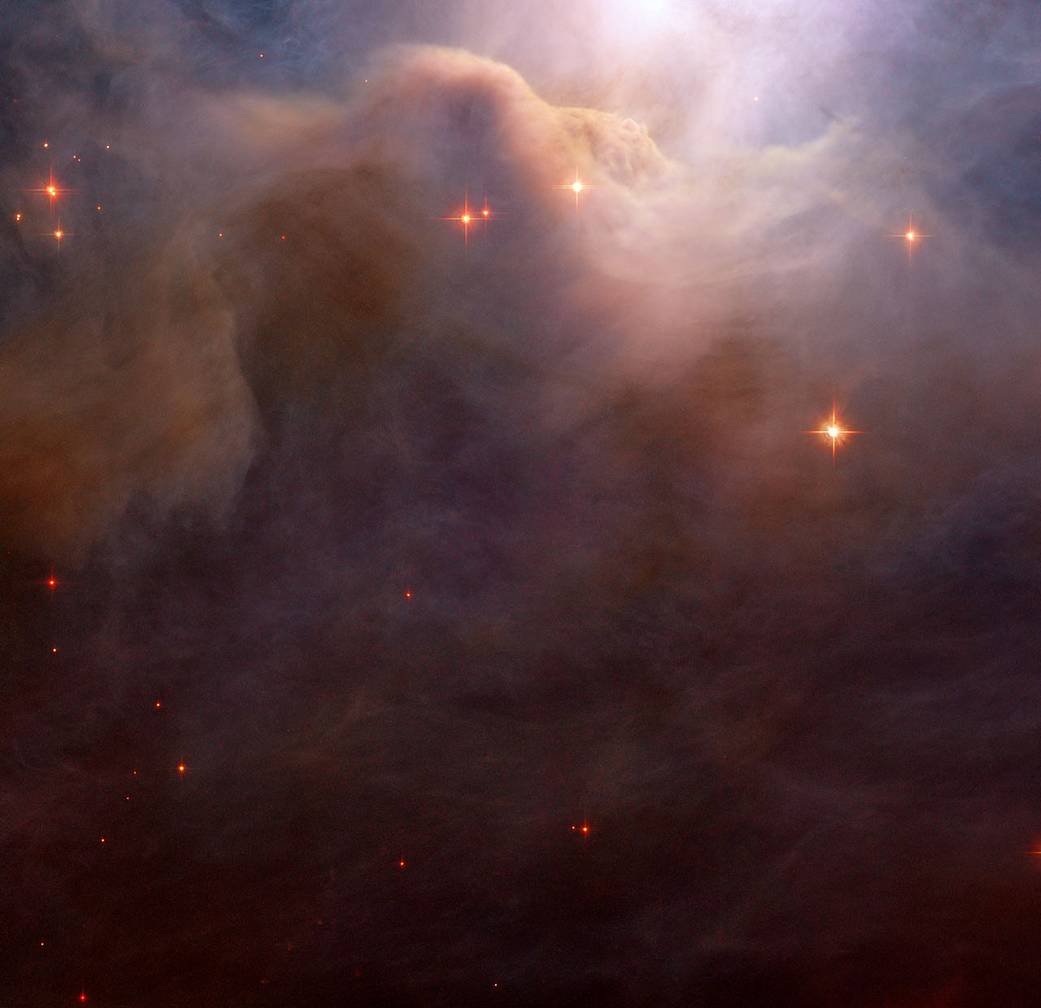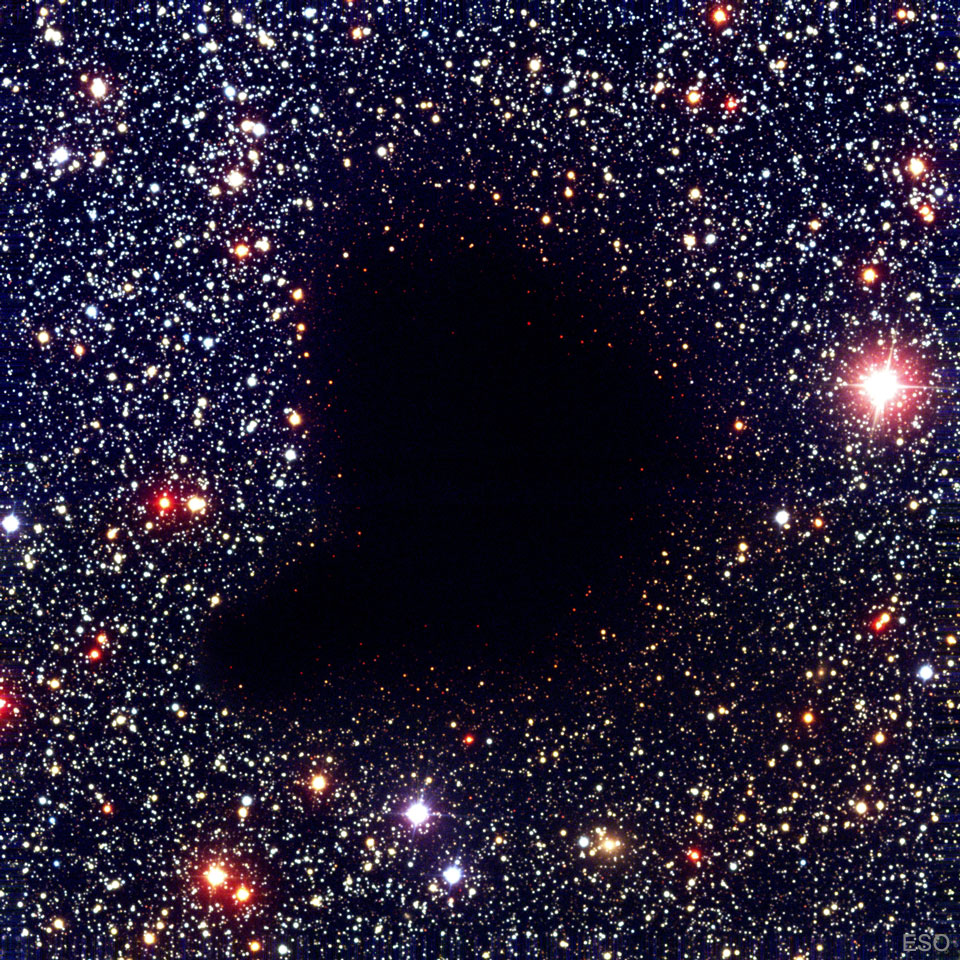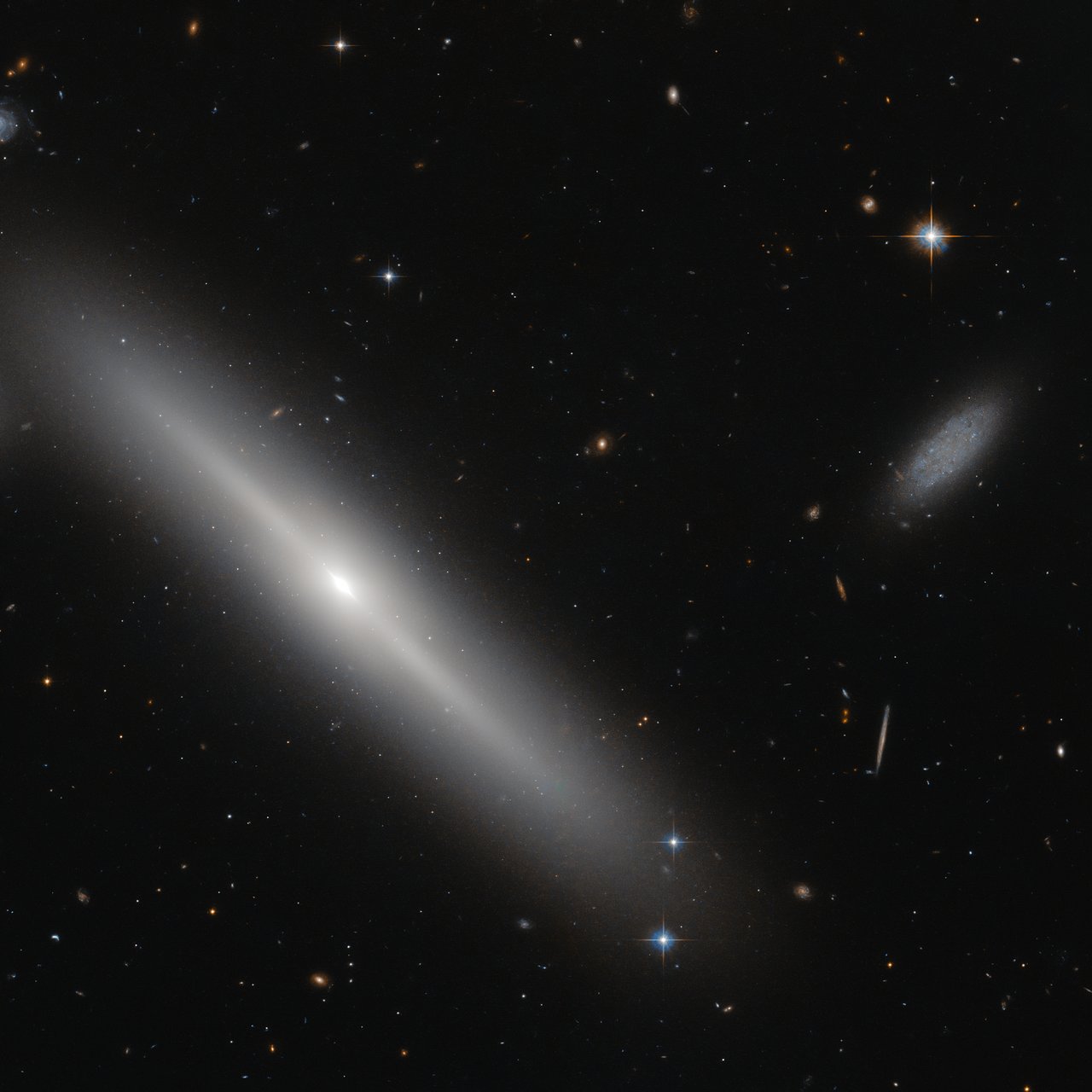Blog
This beautiful, blushing nebula is unique amongst its counterparts. While many of the nebulae visible in the night sky are emission nebulae — clouds of dust and gas that are hot enough to emit their own radiation and light — Caldwell 4, otherwise known as the Iris Nebula or NGC 7023, is a reflection nebula. This means that its color comes from the scattered light of its central star, which lies nestled in the abundant star fields of the constellation Cepheus. Located some 1,400 light-years away from Earth, the Iris Nebula’s glowing gaseous petals stretch roughly 6 light-years across.
This nebula is of particular interest to scientists because of its colors. Reflection nebulae glow because they are made up of extremely tiny particles of solid matter, up to 10 or even 100 times smaller than dust particles on Earth. These particles diffuse the light around them, giving the nebula a second-hand glow that’s typically bluish (like our sky). While the Iris Nebula appears predominantly blue, it includes large filaments of deep red, indicating the presence of an unknown chemical compound likely based on hydrocarbons. Studying nebulae like this one helps astronomers learn more about the ingredients that combine to make stars.
This close-up image, showing one rosy-colored region within Caldwell 4, is a composite of four exposures captured by Hubble’s Advanced Camera for Surveys in visible and near-infrared filters. Astronomers also studied the nebula with Hubble’s Near Infrared Camera and Multi-Object Spectrometer to determine which chemical elements are present in Caldwell 4.

Ludovico Maria Enrico Einaudi OMRI (Italian: [ludoˈviːko eiˈnaudi] (![]() listen); born 23 November 1955) is an Italian pianist and composer. Trained at the Conservatorio Verdi in Milan, Einaudi began his career as a classical composer, later incorporating other styles and genres such as pop, rock, folk, and world music.
listen); born 23 November 1955) is an Italian pianist and composer. Trained at the Conservatorio Verdi in Milan, Einaudi began his career as a classical composer, later incorporating other styles and genres such as pop, rock, folk, and world music.
Einaudi has composed the scores for a number of films and television productions, including This Is England, The Intouchables, I’m Still Here, the TV miniseries Doctor Zhivago, and Acquario (1996), for which he won the Grolla d’oro award. He has also released a number of solo albums for piano and other instruments, notably I Giorni in 2001, Nightbook in 2009, and In a Time Lapse in 2013. On 1 March 2019, Einaudi announced a seven-part project named Seven Days Walking, which was released over the course of seven months in 2019.
more...R. L. Burnside (November 23, 1926 – September 1, 2005) was an American blues singer, songwriter and guitarist. He played music for much of his life but received little recognition before the early 1990s. In the latter half of that decade, Burnside recorded and toured with Jon Spencer, garnering crossover appeal and introducing his music to a new fan base in the punk and garage rock scenes.
Burnside was born in 1926 to Earnest Burnside and Josie Malone, in either Harmontown, College Hill, or Blackwater Creek, all of which are in the rural part of Lafayette County, Mississippi, near the area that would be covered by Sardis Lake a few years later. His first name is given variously as R. L., Rural, Robert Lee, Rule, or Ruel. His father left the family early on, and R. L. grew up with his mother, grandparents, and several siblings.
more...John Alfred Mandel (November 23, 1925 – June 29, 2020) was an American composer and arranger of popular songs, film music and jazz. The musicians he worked with include Count Basie, Frank Sinatra, Peggy Lee, Anita O’Day, Barbra Streisand, Tony Bennett, Diane Schuur and Shirley Horn. He won 5 Grammy Awards – from 17 nominations; his first nomination was for his debut film score for the multi-nominated 1958 film I Want to Live!. Mandel was born in Manhattan on November 23, 1925. His father, Alfred, was a garment manufacturer who ran Mandel & Cash; his mother, Hannah (Hart-Rubin), had aimed to be an opera singer and discovered her son had perfect pitch at the age of five. His family was Jewish. They moved to Los Angeles in 1934, after his father’s business collapsed during the Great Depression. Mandel was given piano lessons, but switched to the trumpet and later the trombone. Mandel studied at the Manhattan School of Music and the Juilliard School. In 1943, he played the trumpet with jazz violinist Joe Venuti. The following year, he worked with Billy Rogers and played trombone in the bands of Boyd Raeburn, Jimmy Dorsey, Buddy Rich, Georgie Auld and Chubby Jackson. In 1949 he accompanied the singer June Christy in the orchestra of Bob Cooper. From 1951 until 1953 he played and arranged music in Elliot Lawrence‘s orchestra, and in 1953 with Count Basie. He subsequently resided in Los Angeles, where he played the bass trumpet for Zoot Sims.
more...Manuel de Falla y Matheu (Spanish pronunciation: [maˈnwel ðe ˈfaʎa], 23 November 1876 – 14 November 1946) was a Spanish composer and pianist. Along with Isaac Albéniz, Francisco Tárrega, and Enrique Granados, he was one of Spain’s most important musicians of the first half of the 20th century. He has a claim to being Spain’s greatest composer of the 20th century, although the number of pieces he composed was relatively modest.
more...What used to be considered a hole in the sky is now known to astronomers as a dark molecular cloud. Here, a high concentration of dust and molecular gas absorb practically all the visible light emitted from background stars. The eerily dark surroundings help make the interiors of molecular clouds some of the coldest and most isolated places in the universe. One of the most notable of these dark absorption nebulae is a cloud toward the constellation Ophiuchus known as Barnard 68, pictured here. That no stars are visible in the center indicates that Barnard 68 is relatively nearby, with measurements placing it about 500 light-years away and half a light-year across. It is not known exactly how molecular clouds like Barnard 68 form, but it is known that these clouds are themselves likely places for new stars to form. In fact, Barnard 68itself has been found likely to collapse and form a new star system. It is possible to look right through the cloud in infrared light.

more...
Aston Francis Barrett (born 22 November 1946), often called “Family Man” or “Fams” for short, is a Jamaican musician and Rastafarian.
Born in Kingston, Jamaica, Aston “Family Man” Barrett was one of the Barrett brothers (the other being the younger brother on drums Carlton “Carly” Barrett) who played with Bob Marley and The Wailers, The Hippy Boys, and Lee Perry‘s The Upsetters. He was the bandleader of Marley’s backing band, as well as co-producer of the albums, and the man in charge of the overall song arrangements.
Barrett continues to tour with and lead The Wailers Band. He has great support from Marley’s fan base to this day, despite his legal wrangling with the Marley family. Barrett was the mentor and teacher of Robbie Shakespeare of the duo Sly & Robbie.
more...Perry Miller (born November 22, 1941 Queens, NY), known professionally as Jesse Colin Young, is an American singer and songwriter. He was a founding member and lead singer of the 1960s group the Youngbloods. After their dissolution in 1972, Young embarked on a solo career, releasing a series of successful albums through Warner Bros. Records, including Song for Juli (1973), Light Shine (1974), Songbird (1975) and the live album On the Road(1976). Young continued to release music in the 1980s with Elektra Records and Cypress Records, before deciding to release music through his personal label, Ridgetop Music, in 1993. After the Mount Vision Fire in 1995, Young relocated with his family to a coffee plantation in Hawaii, periodically releasing music. Young was diagnosed with Lyme disease in 2012, and decided to retire from music. He began performing again in 2016 with his son Tristan, releasing a new album Dreamers in 2019 through BMG.
Young’s song “Sunlight” was covered by Three Dog Night on their album Naturally (1970), and “Darkness, Darkness” by Robert Plant in 2002, which received a nomination for the Grammy Award for Best Male Rock Vocal Performance.
more...
James Minter Knepper (November 22, 1927 – June 14, 2003) was an American jazz trombonist. In addition to his own recordings as leader, Knepper performed and recorded with Charlie Barnet, Woody Herman, Claude Thornhill, Stan Kenton, Benny Goodman, Gil Evans, Thad Jones and Mel Lewis, Toshiko Akiyoshi and Lew Tabackin, and, most famously, Charles Mingus in the late 1950s and early 1960s. Knepper died in 2003 of complications of Parkinson’s disease.
Knepper was born in Los Angeles, California, the second son of a nurse and a police officer. His parents divorced shortly after his birth, and his mother had to take her abusive husband to court in order to get child support. He and his older brother, Robert, were sent to several boarding and military schools, Page Military Academy and St. John’s Military Academy, while their mother worked. He picked up his first instrument, an alto horn, at the age of 6 while he was a pupil there. His first teacher persuaded him to put aside the alto and pick up the trombone because, as he said, he had a “trombone mouth”. He played his first professional gigs in LA, and traveled to Spokane, WA at the age of 15. He graduated high school, and later attended classes at Los Angeles Community College.
more...Edward Benjamin Britten, Baron Britten OM CH (22 November 1913 – 4 December 1976) was an English composer, conductor, and pianist. He was a central figure of 20th-century British music, with a range of works including opera, other vocal music, orchestral and chamber pieces. His best-known works include the opera Peter Grimes (1945), the War Requiem (1962) and the orchestral showpiece The Young Person’s Guide to the Orchestra (1945).
Born in Lowestoft, Suffolk, the son of a dentist, Britten showed talent from an early age. He studied at the Royal College of Music in London and privately with the composer Frank Bridge. Britten first came to public attention with the a cappella choral work A Boy was Born in 1934. With the premiere of Peter Grimes in 1945, he leapt to international fame. Over the next 28 years, he wrote 14 more operas, establishing himself as one of the leading 20th-century composers in the genre. In addition to large-scale operas for Sadler’s Wells and Covent Garden, he wrote chamber operas for small forces, suitable for performance in venues of modest size. Among the best known of these is The Turn of the Screw (1954). Recurring themes in his operas include the struggle of an outsider against a hostile society and the corruption of innocence.
Britten’s other works range from orchestral to choral, solo vocal, chamber and instrumental as well as film music. He took a great interest in writing music for children and amateur performers, including the opera Noye’s Fludde, a Missa Brevis, and the song collection Friday Afternoons. He often composed with particular performers in mind. His most frequent and important muse was his personal and professional partner, the tenor Peter Pears; others included Kathleen Ferrier, Jennifer Vyvyan, Janet Baker, Dennis Brain, Julian Bream, Dietrich Fischer-Dieskau and Mstislav Rostropovich. Britten was a celebrated pianist and conductor, performing many of his own works in concert and on record. He also performed and recorded works by others, such as Bach‘s Brandenburg Concertos, Mozart symphonies, and song cycles by Schubert and Schumann.
Together with Pears and the librettist and producer Eric Crozier, Britten founded the annual Aldeburgh Festival in 1948, and he was responsible for the creation of Snape Maltings concert hall in 1967. In his last year, he was the first composer to be given a life peerage.
more...Hoagland Howard “Hoagy” Carmichael (November 22, 1899 – December 27, 1981 Bloomington, IN) was an American singer, songwriter, and actor. American composer and author Alec Wilder described Carmichael as the “most talented, inventive, sophisticated and jazz-oriented of all the great craftsmen” of pop songs in the first half of the 20th century. Carmichael was one of the most successful Tin Pan Alley songwriters of the 1930s and was among the first singer-songwriters in the age of mass media to utilize new communication technologies, such as television and the use of electronic microphones and sound recordings.
Carmichael composed several hundred songs, including 50 that achieved hit record status. He is best known for composing the music for “Stardust“, “Georgia on My Mind” (lyrics by Stuart Gorrell), “The Nearness of You“, and “Heart and Soul” (in collaboration with lyricist Frank Loesser), four of the most-recorded American songs of all time. He also collaborated with lyricist Johnny Mercer on “Lazybones” and “Skylark.” Carmichael’s “Ole Buttermilk Sky” was an Academy Award nominee in 1946, from Canyon Passage, in which he co-starred as a musician riding a mule. “In the Cool, Cool, Cool of the Evening,” with lyrics by Mercer, won the Academy Award for Best Original Song in 1951. Carmichael also appeared as a character actor and musical performer in 14 films, hosted three musical-variety radio programs, performed on television, and wrote two autobiographies.
more...This NASA/ESA Hubble Space Telescope image shows star clusters encircling a galaxy, like bees buzzing around a hive. The hive in question the an edge-on lenticular galaxy NGC 5308, located just under 100 million light-years away in the constellation of Ursa Major (The Great Bear). Members of a galaxy type that lies somewhere between an elliptical and a spiral galaxy, lenticular galaxies such as NGC 5308 are disc galaxies that have used up, or lost, the majority of their gas and dust. As a result, they experience very little ongoing star formation and consist mainly of old and aging stars. On 9 October 1996, one of NGC 5308’s aging stars met a dramatic demise, exploding as a spectacular Type la supernova. Lenticular galaxies are often orbited by gravitationally bound collections of hundreds of thousands of older stars. Called globular clusters, these dense collections of stars form a delicate halo as they orbit around the main body of NGC 5308, appearing as bright dots on the dark sky. The dim, irregular galaxy to the right of NGC 5308 is known, rather prosaically, as SDSS J134646.18+605911.9

Alphonse Lee Mouzon (November 21, 1948 – December 25, 2016) was an American jazz fusion drummer and the owner of Tenacious Records, a label that primarily released Mouzon’s recordings. He was a composer, arranger, producer, and actor. He gained popularity in the late 1960s and early 1970s. His cute track called Lullaby for Little Alphonso was a big hit in the Philippines.during the Jazz Fusion era when it was selected as the main background music for the “Miss Little Philippines” – a beauty/talent contest which ran for several months in a popular noon time show.
Mouzon, of African, French, and Blackfoot descent, was born on November 21, 1948, in Charleston, South Carolina. He received his first musical training at Bonds-Wilson High School, and moved to New York City upon graduation. He studied drama and music at the City College of New York, as well as medicine at Manhattan Medical School. He continued receiving drum lessons from Bobby Thomas, the drummer for jazz pianist Billy Taylor. He played percussion in the 1968 Broadway show Promises, Promises, and he then worked with pianist McCoy Tyner. He spent a year as a member of the jazz fusion band, Weather Report. After that Mouzon signed as a solo artist to the Blue Note label in 1972.
https://www.youtube.com/watch?v=HnZ70TvliA8
more...Nouhad Wadie’ Haddad (Arabic: نهاد وديع حداد; born November 20, 1934), known as Fairuz (Arabic: فيروز), also spelled Fairouz, Feyrouz or Fayrouz, is a Lebanese singer. She is considered by many as one of the leading vocalists and most famous singers in the history of Arab world. Fairuz is considered the musical icon of Lebanon, comparable to Edith Piaf in France, Elvis Presley in the United States and Lys Assiain Switzerland.
Fairuz began her musical career as a teenager at the national radio station in Lebanon in the late 1940s as a chorus member. Her first major hit “Itab” came in 1952 which made her an instant star in the Arab world.In the summer of 1957, Fairuz held her first live performance at the Baalbeck International Festival where she was awarded with the honor of “Cavalier”, the highest medal for artistic achievement by Lebanese president Camille Chamoun.
Fairuz’s fame spread throughout the Arab world in the 1950s and 1960s and she would perform outside of Lebanon in various Arab capitals Damascus, Amman, Cairo, Rabat, Algiers, and Tunis. She has received multiple recognitions and awards throughout her career including a Lebanese memorial stamp issued in 1969, the Key to the Holy City awarded by the Jerusalem Cultural Committee, the Jordanian Medal of Honor presented by King Hussein of Jordan, the Commandeur des Arts et des Lettres (Order of Arts and Letters) awarded by French President François Mitterrand in 1988, the Highest Artistic Distinction, awarded by Tunisian President Zine El Abidine Ben Ali, the Chevalier de la Legion d’honneur (National Order of the Legion of Honor) awarded by French President Jacques Chirac and Honorary Doctorate from the American University of Beirut in 2005.
https://www.youtube.com/watch?v=BaG_wp_bWXA
more...More Posts
- Kenny Barron Day
- Les Paul Day
- Cole Porter Day
- World Music with Zemari Zerfe Kebede
- Daily Roots with Scientist
- The Cosmos with NGC 346
- Boz Scaggs Day
- Bill Watrous Day
- Billie Pierce Day
- World Music with Alba Molina
- Daily Roots with King Tubbyhttps://www.youtube.com/watch?v=TOxKeKRIhhI
- The Cosmos with NGC 3256
- Tina Brooks Day
- Tal Farlow Day
- World Fusion with Frédéric Galliano & the African Divas
- Daily Roots with Scientist
- The Cosmos with Chamaeleon I
- Monty Alexander Day
- Grant Green Day
- Al Grey Day